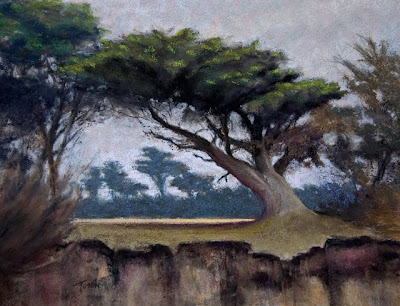
Cliff-Defying
Pastel
12x16
Poplar Beach in Half Moon Bay offers dramatic views. Take the pathway South from the parking lot, and you come to this cyprus grove overhanging a cliff.
View Larger Map

 I started with a few quick sketches each around 2” x 3” to try different compositions. From this I quickly moved to blocking in a composition using a water-based media on Wallis sanded paper mounted on museum board.
I started with a few quick sketches each around 2” x 3” to try different compositions. From this I quickly moved to blocking in a composition using a water-based media on Wallis sanded paper mounted on museum board.


In my critic group I was explaining the steps I take to cleanup photos of my paintings. There was a fair amount of interest, so I thought I’d write it up for those that are curious. Following this process I can now reliably touch up a photo in just a few minutes.
First - it's a good idea to have your computer monitor calibrated. I use a product called 'color munki' from x-rite. Otherwise you might adjust a photo to look good on your monitor, but it will look wrong/incorrect elsewhere. The first time you calibrate your monitor you will probably find that the monitor needed to be tweaked quite a bit (which incidentally also points out that anyone viewing your work without a calibrated monitor is likely to see variability in the colors, so don’t get too worried about perfection if you are only cleaning up photos for use on the web).
I photograph artwork in my studio. I'm fortunate that I have good natural light, and I often rely on this. But I also have good artificial light with a mix of full-spectrum bulbs - and I find I can take photos at night with acceptable results. The photo must be in focus and evenly lit with no hot spots. But color temperature and dim lighting can be adjusted. The photo should also be nice and square in the viewfinder (it should look like a rectangle with 90 degree corners – not like a trapezoid).
Once I have the photo, these are the steps I take with Photoshop to clean it up:
If you’re unfamiliar with the tools I’ve mentioned, use Photoshop help to get some additional instructions on using any of these tools. Good luck.
